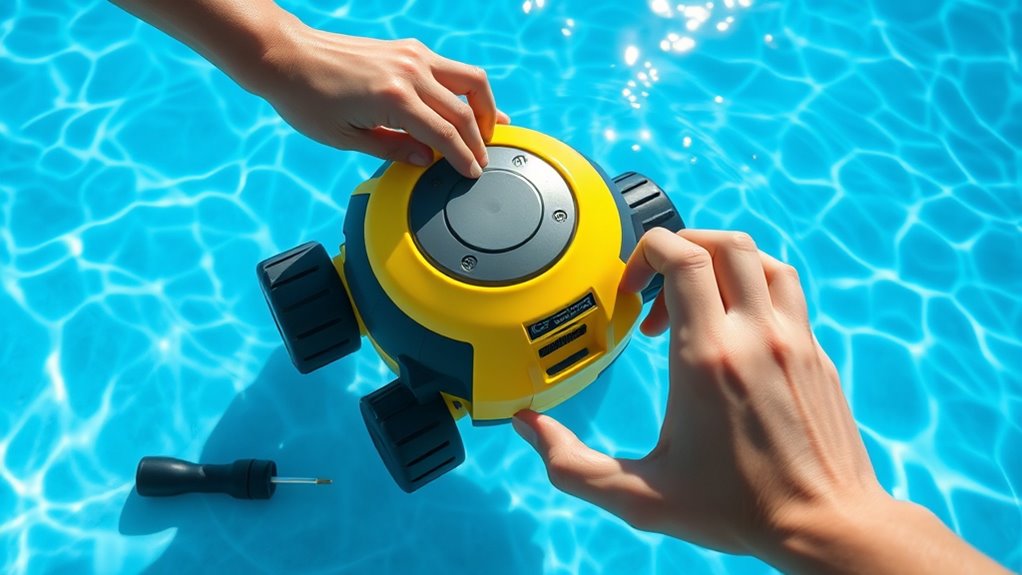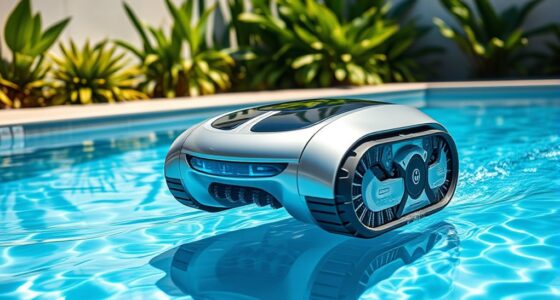If your automatic pool cleaner isn’t working well, start by checking the power source and electrical connections for damage or loose wires. Inspect the brushes, squeegee, and hoses for debris or wear, and make sure the water level is correct. Verify the skimmer and valves aren’t clogged and that the water flow is strong. Test the drive motor and navigation system. For more helpful tips, continue exploring tips to keep your cleaner in top shape.
Key Takeaways
- Check the power supply, electrical connections, and test the drive motor for proper operation.
- Inspect and clean brushes, squeegee, hoses, and swivels for wear, debris, or kinks.
- Ensure water level is correct and remove surface debris to optimize cleaning performance.
- Verify water flow through valves and clear obstructions to maintain system functionality.
- Regularly maintain pool water chemistry and filters to prevent debris buildup and equipment damage.
Checking the Power Source and Connections

If your pool cleaner isn’t working, the first step is to check the power source and connections. Power surges can disrupt the flow of electricity, causing your cleaner to stop functioning. Unplug the unit and inspect the power cord for any visible damage. Faulty wiring is another common issue; look for frayed or loose connections that might prevent proper power transfer. Ensure that the outlet is working by plugging in another device. If your cleaner still won’t turn on, reset any GFCI outlets or circuit breakers. Sometimes, the problem isn’t with the cleaner but with the power supply. Addressing power surges and faulty wiring early on can save you time and prevent further damage to your pool cleaner’s electrical components. Additionally, understanding the importance of electrical safety can help you troubleshoot effectively without risking injury. Checking for proper grounding can also prevent electrical faults and ensure safe operation of your equipment. Being aware of power fluctuations can further aid in maintaining consistent operation of your pool cleaner. Regularly inspecting and maintaining your electrical connections can also help prevent electrical faults from occurring unexpectedly.
Inspecting and Cleaning the Brushes and Squeegee
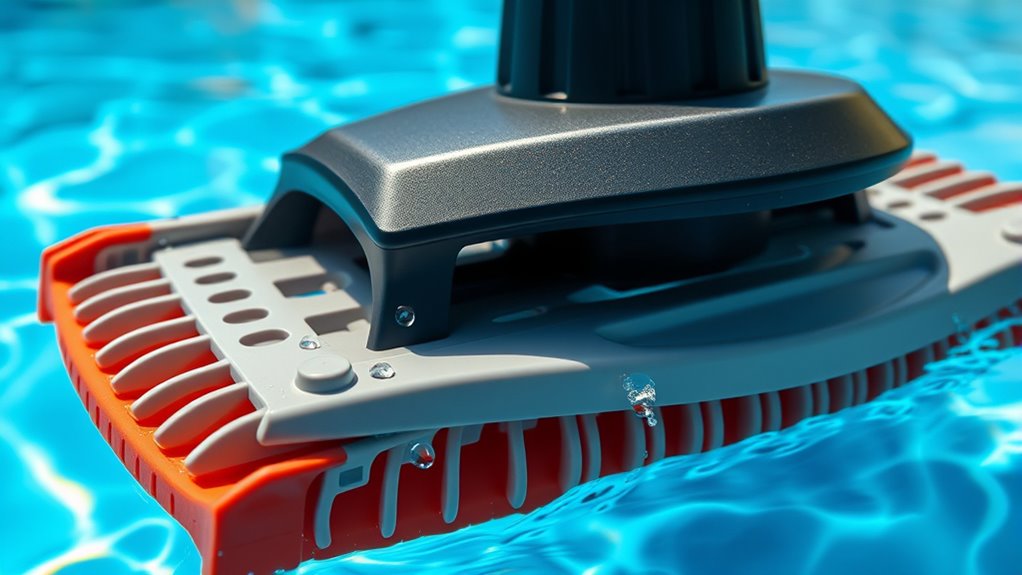
Start by checking your brushes for signs of wear, and replace them if they’re worn down. Remove any debris buildup that could hinder cleaning performance. Also, inspect the squeegee to make certain it’s in good condition and making proper contact with the pool surface. Additionally, consider inspecting the performance upgrades of your cleaner to ensure it operates at optimal efficiency. Regularly reviewing the glycolic acid benefits can help maintain healthy skin, which is important if you experience irritation from pool chemicals. Being aware of essential oils for respiratory health can also provide relief if you notice irritation or congestion caused by chemical fumes. Remember that proper maintenance and paint sprayer tips can extend the lifespan of your equipment and improve its performance. Ensuring your equipment is well-maintained can prevent common issues like clogs or uneven cleaning, similar to how proper airless paint sprayer maintenance improves painting results.
Check Brush Wear
Regularly inspecting the brushes and squeegee on your pool cleaner guarantees it operates efficiently. Start with a thorough wear assessment to check the brush condition. Look for signs of fraying, cracks, or missing bristles, which can reduce cleaning effectiveness. If the brushes are worn down or damaged, they won’t pick up debris properly, leading to missed spots. Make sure the squeegee is flexible and free of cuts or tears, as a compromised squeegee can impair water flow and debris removal. Cleaning the brushes with a hose can help remove dirt and algae buildup, but if the wear assessment reveals significant deterioration, replace the brushes or squeegee promptly. Keeping these components in good shape ensures your cleaner performs at its best. Additionally, understanding how automation in business is improving operational efficiency can help you appreciate the importance of maintaining your equipment. Recognizing the role of AI in cybersecurity and other sectors highlights how technology can support maintenance and troubleshooting efforts.
Remove Debris Buildup
Inspecting and cleaning the brushes and squeegee regularly helps prevent debris buildup that can hinder your pool cleaner’s performance. When debris accumulates, it can trap algae growth and worsen a chemical imbalance, making your pool harder to keep clean. Check the brushes for tangled leaves, dirt, or algae, which can reduce scrubbing efficiency. Clean the squeegee to guarantee it seals properly and removes debris effectively. Use the table below to guide maintenance:
| Task | Signs of Buildup | Cleaning Method |
|---|---|---|
| Brush Inspection | Stuck debris, algae growth | Rinse with water, scrub if needed |
| Squeegee Check | Reduced suction or leaks | Wipe with a cloth and rinse |
| Debris Removal | Excess leaves, dirt | Remove manually or with hose |
| Algae Control | Green spots or film | Clean thoroughly and check chemical levels |
| Chemical Balance | Cloudy water, algae presence | Adjust chemicals as needed |
Regular checks keep your cleaner functioning at its best. Incorporating proper maintenance techniques can further extend the life of your pool cleaner and ensure optimal performance. Additionally, inspecting filter components regularly helps maintain consistent cleaning efficiency. Maintaining proper suction power is essential for effective debris removal and overall cleaner performance.
Inspect Squeegee Condition
To guarantee your pool cleaner operates effectively, it’s vital to evaluate the condition of the squeegee regularly. Check for cracks, tears, or debris that could impair its cleaning ability. Ensure the squeegee maintains proper flexibility; a stiff or brittle squeegee won’t conform to the pool surface properly. Proper squeegee alignment is essential—misaligned squeegees can leave spots or miss debris. Clean the squeegee with a soft cloth to remove dirt and buildup. Regular inspection helps prevent cleaning failures and prolongs your cleaner’s lifespan. Additionally, inspecting the fabric decorating markers can help ensure your cleaning tools remain in optimal condition for maintenance or personalization. Staying informed about credit card security measures can also help protect your financial data if you use online payment options for pool maintenance supplies. Regularly reviewing safety standards and installation considerations can further ensure your pool area remains secure and hazard-free. Moreover, consulting the manufacturer’s guidelines can provide specific maintenance tips for your particular model. Recognizing signs of angel number soulmate patterns can also inspire confidence in your relationship goals and motivate timely repairs or upgrades to your equipment.
Examining the Skimmer and Intake Valves
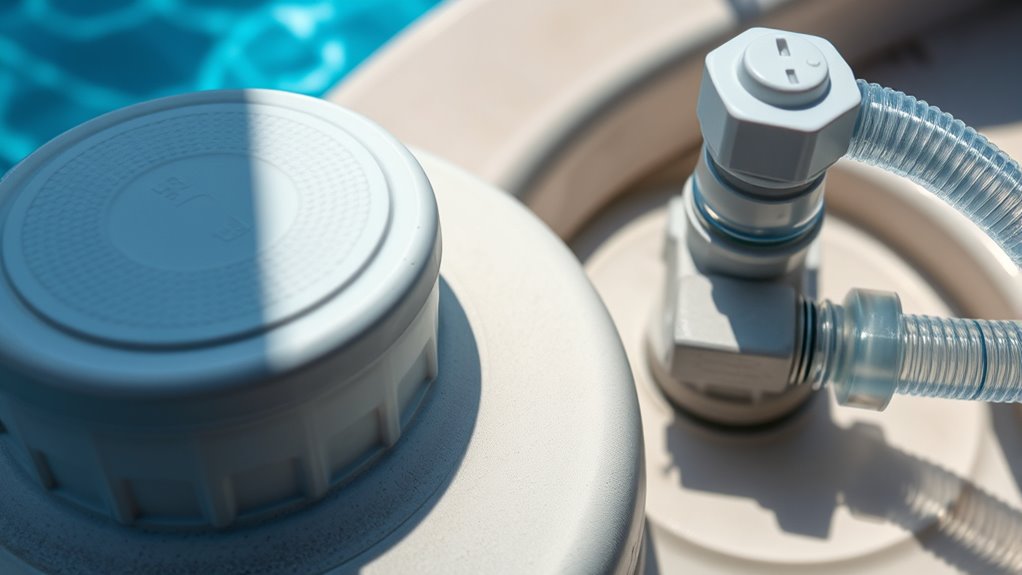
Start by checking if the skimmer and intake valves are operating smoothly. Look for any obstructions that could block water flow, and clear them out carefully. Ensuring these valves work properly can make a big difference in your pool cleaner’s performance. Additionally, verifying the trustworthiness of water flow can help prevent recurring issues with the cleaner. Monitoring the water pressure levels regularly can also aid in maintaining optimal operation of your pool system. Regularly inspecting the security features of your pool equipment can further ensure reliable performance and catch potential problems early. Incorporating space and organization strategies, such as designated maintenance areas, can make troubleshooting more efficient and less stressful.
Inspect Valve Operation
Have you checked whether your skimmer and intake valves are functioning properly? Proper valve operation is essential for efficient cleaning. Start by inspecting the valves for leaks, cracks, or blockages that could hinder flow. Ensure they are correctly calibrated to maintain ideal flow regulation, which affects how well your cleaner operates. If flow seems weak or inconsistent, adjusting the valve calibration might improve performance. Confirm that the valves open and close smoothly without resistance. Also, verify that the valves are fully open when the cleaner is running. Regularly checking these components helps prevent issues caused by improper flow regulation, ensuring your pool cleaner does its job effectively.
- Check for leaks, cracks, or blockages
- Confirm valves open and close smoothly
- Ensure valves are fully open during operation
- Adjust valve calibration for better flow regulation
- Watch for inconsistent or weak flow
Clear Obstructions Properly
Obstructions in the skimmer and intake valves can substantially impair your pool cleaner’s performance. To clear them properly, turn off your pool pump first. Inspect the skimmer basket and intake valves for debris like leaves, hair, or dirt, which can block water flow. Make sure the pool’s chemical balance is correct, as imbalanced chemicals can cause debris buildup or algae that clog these areas. Also, check the pool water temperature, since warmer water can increase debris and algae growth, worsening obstructions. Remove any debris carefully, using a net or brush if needed. Rinsing the skimmer basket and valves thoroughly before reinstalling helps prevent future clogs. Regular maintenance of these components guarantees your cleaner operates efficiently and prevents future blockages. Proper water quality management is essential for maintaining optimal water flow, reducing the likelihood of obstructions and ensuring your pool cleaner functions effectively. Additionally, maintaining proper chemical balance supports overall water clarity and reduces debris accumulation. Incorporating routine inspections of your skimmer components can help catch potential issues early. Utilizing smart monitoring tools can also assist in identifying emerging problems before they cause significant clogs.
Testing the Drive Motor and Wheels
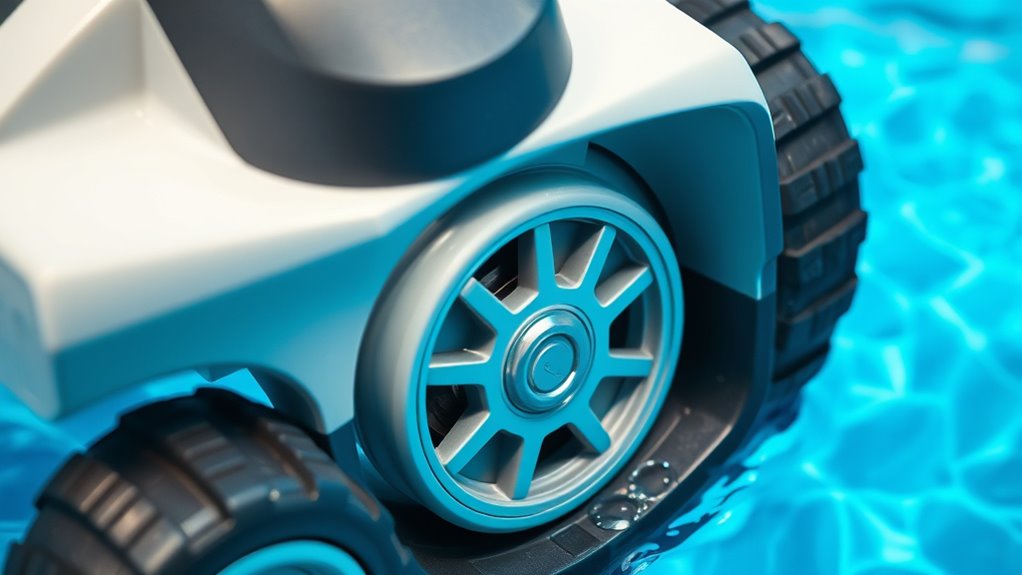
To effectively troubleshoot your pool cleaner, you need to verify that the drive motor and wheels are functioning properly. Start with drive motor diagnostics to ensure it runs smoothly without unusual noises or stalls. Check the wheels for proper wheel alignment; misaligned wheels can hinder movement and coverage. Observe if the wheels spin freely and consistently when the cleaner is powered on. If you notice sluggish movement or irregular rotation, the motor or wheels may need replacing or adjustment.
Ensure your pool cleaner’s drive motor and wheels are working properly for effective troubleshooting.
- Inspect the drive motor for debris or damage
- Listen for unusual sounds during operation
- Confirm wheels turn smoothly without resistance
- Check wheel alignment for proper positioning
- Test the motor’s response when initiating movement
Ensuring Proper Navigation and Coverage

Ensuring your pool cleaner navigates effectively and covers the entire pool area is key to achieving a thorough clean. Start by checking the navigation algorithms, which guide the cleaner’s movements. If your cleaner isn’t covering all areas, it might need recalibration or updates to its software. Sensor calibration is also crucial; inaccurate sensors can cause the cleaner to miss spots or get stuck. Clean the sensors regularly and follow the manufacturer’s instructions for calibration to improve navigation accuracy. Additionally, guarantee the cleaner’s path isn’t obstructed by pool features or debris, which can interfere with its algorithms. Properly calibrated sensors and optimized navigation algorithms work together to maximize coverage, reduce missed spots, and ensure your pool stays spotless with minimal effort.
Verifying the Pool’s Water Level and Debris Status
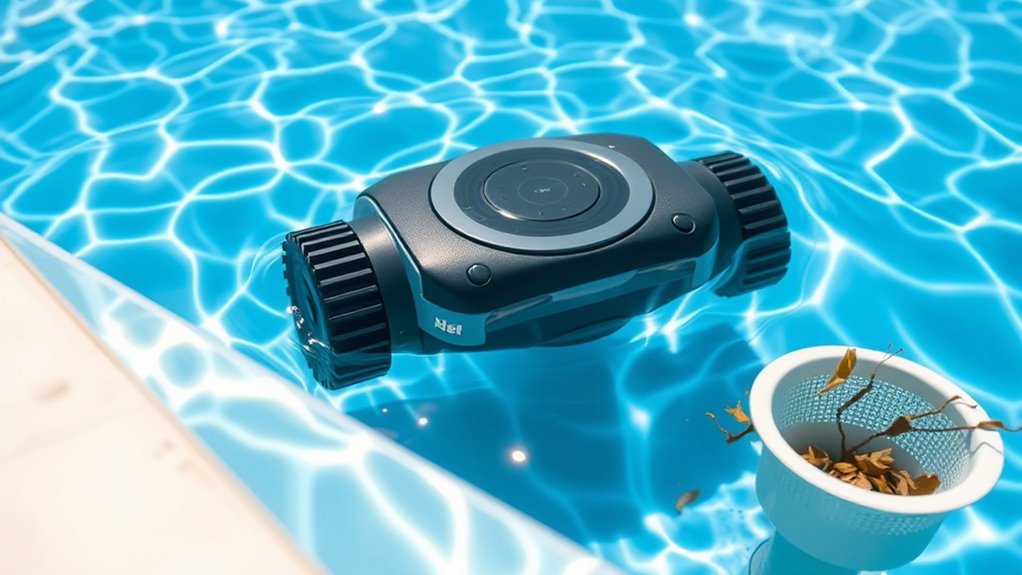
Checking the pool’s water level and debris status is essential for ideal cleaner performance. An appropriate water level guarantees the cleaner operates smoothly without interruptions. Debris buildup can clog filters or impede movement. Also, inspect water chemistry, as imbalances can affect how well the cleaner functions and impact pool lighting visibility.
- Maintain water at the proper level, roughly halfway up the skimmer opening
- Remove visible debris like leaves or twigs from the surface
- Check for algae or dirt that could clog the cleaner’s intakes
- Ensure water chemistry is balanced to promote efficient cleaning
- Confirm pool lighting isn’t obstructed by debris or water level issues
Keeping these in check optimizes cleaner efficiency and keeps your pool sparkling.
Troubleshooting the Control System and Remote Functions
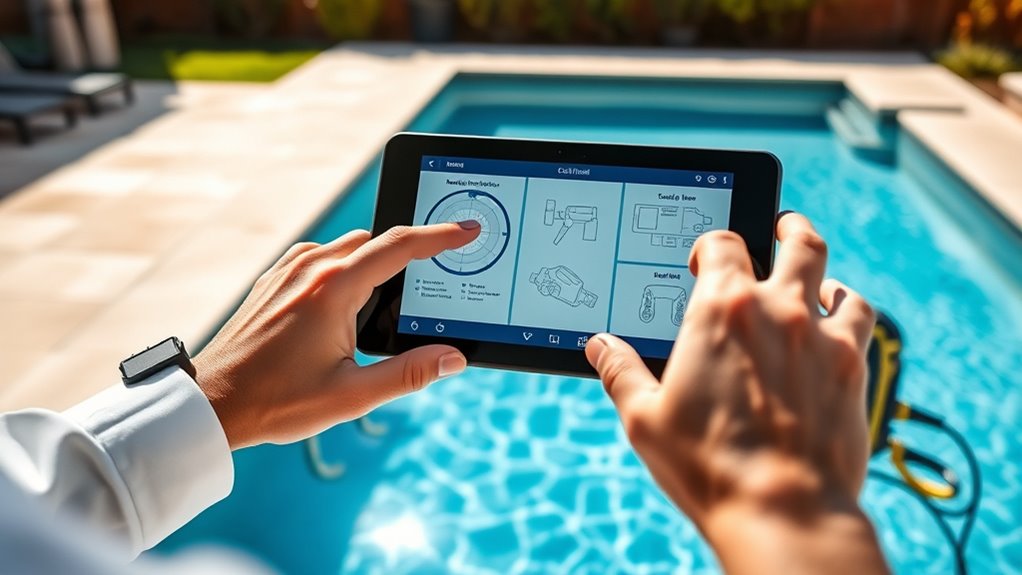
Problems with the control system or remote functions can prevent your pool cleaner from operating correctly, even if the hardware looks fine. First, check remote connectivity — ensure your remote is within range and batteries are fresh. Sometimes, interference from other devices disrupts signals. Next, verify if your software needs updates; outdated firmware can cause communication issues. Use the app or control panel to scan for updates. Here’s a quick visual:
| Issue | Solution | Result |
|---|---|---|
| Remote not responding | Re-establish connection | Cleaner responds again |
| Software outdated | Perform update via app | Improved functionality |
| Signal interference | Move closer or remove obstacles | Stable remote control |
Keeping software current and ensuring strong remote connectivity are key to smooth operation.
Replacing or Repairing Damaged Parts
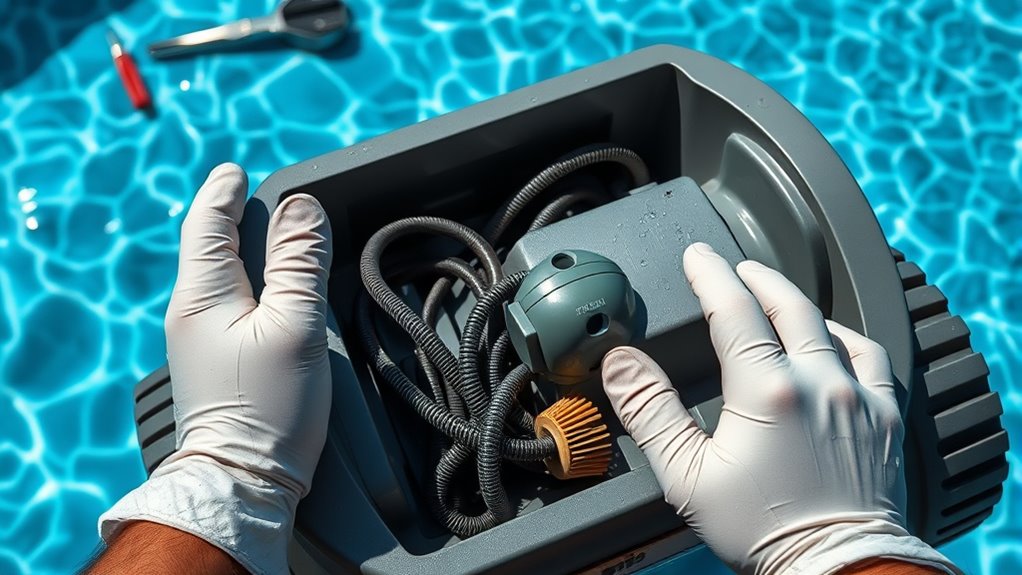
When your pool cleaner isn’t functioning properly despite proper control and remote setup, damaged or worn parts are often to blame. To fix this, you may need to replace or repair components like brushes, hoses, or the drive motor. Before doing so, verify your pool’s chemical balance is correct, as imbalances can affect cleaner performance. Also, inspect the pool liner for tears or obstructions that could interfere with movement.
If your pool cleaner isn’t working, check for worn parts, chemical balance, and liner obstructions.
Here are some key steps:
- Check for cracks or tears in hoses and replace if damaged
- Inspect brushes for excessive wear and swap out if needed
- Test the drive motor for signs of malfunction
- Replace worn-out seals or gaskets
- Ensure the cleaner’s wheels and tracks are clean and functional
Performing Regular Maintenance and Preventive Checks
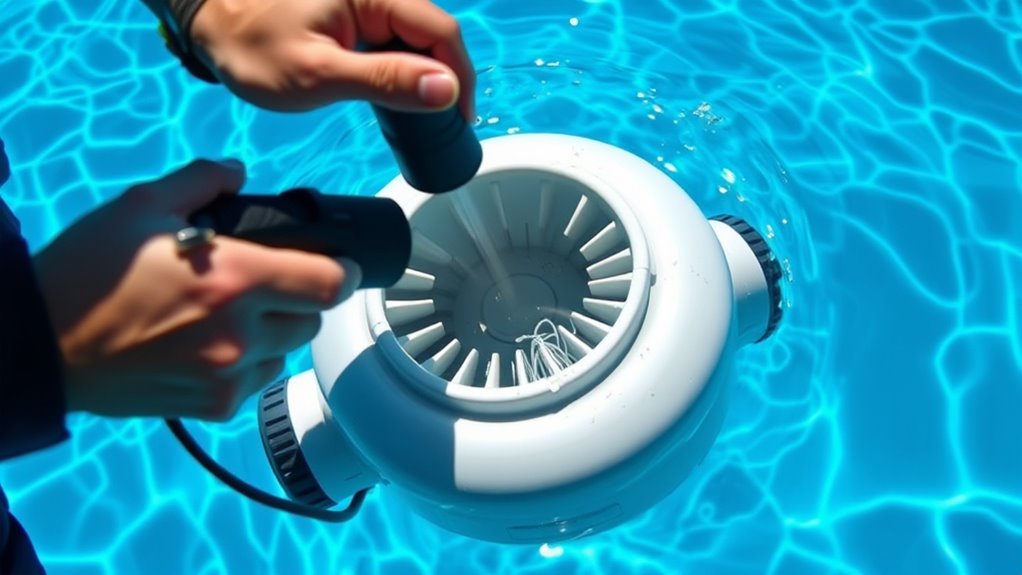
Regular maintenance and preventive checks keep your pool cleaner running smoothly and help catch issues early. Regularly inspect the cleaner’s brushes and filters, and ensure the automatic cleaner programming aligns with your pool’s needs. Monitoring your pool water chemistry is essential; balanced water prevents debris buildup and equipment damage. Additionally, check the hoses and swivels for kinks or wear, replacing parts as needed. Properly maintaining your equipment reduces unexpected breakdowns and extends its lifespan. Here’s a quick overview:
| Maintenance Task | Purpose |
|---|---|
| Check and clean filters | Prevent clogs, improve suction |
| Inspect brushes and hoses | Remove debris, avoid blockages |
| Test automatic programming | Ensure efficient cleaning cycle |
| Monitor water chemistry | Maintain ideal conditions |
| Lubricate moving parts | Reduce wear, prevent corrosion |
Frequently Asked Questions
How Do I Reset My Automatic Pool Cleaner’S Control System?
To reset your automatic pool cleaner’s control system, start with a control panel reset. Turn off the cleaner and unplug it from the power source. Wait for about a minute, then plug it back in. Follow the power cycle procedure by turning the cleaner on again. This simple reset clears any glitches and helps your cleaner operate smoothly. If issues persist, consult your user manual for specific reset instructions.
Why Is My Cleaner Making Unusual Noises During Operation?
If your cleaner makes unusual noises during operation, it might be due to noisy bearings or debris obstruction. Check the bearings for signs of wear or damage, as these can cause grinding sounds. Also, inspect the brushes and wheels for debris that could be hindering movement. Clearing out any debris and replacing worn bearings should help reduce the noise and improve your cleaner’s performance.
Can Algae Buildup Affect My Cleaner’S Performance?
Did you know that algae buildup can reduce your pool cleaner’s efficiency by up to 30%? Yes, algae control is essential for maximum cleaner performance. When algae accumulates, it clogs filters and hampers movement, making cleaner maintenance more difficult. Regularly remove algae and clean your cleaner to guarantee it runs smoothly. Proper algae control keeps your pool cleaner working at peak performance, saving you time and ensuring a sparkling, healthy pool.
How Do I Recalibrate the Cleaner’S Navigation System?
To recalibrate your cleaner’s navigation system, start with navigation calibration by placing it in the pool and turning it on. Observe its movement and look for any irregular patterns. If needed, adjust the sensors by cleaning or repositioning them to guarantee proper sensor adjustment. Reset the system if necessary, following your cleaner’s manual instructions, to help it correctly map the pool and improve its cleaning efficiency.
What Should I Do if the Cleaner Gets Stuck on Pool Steps?
When your cleaner gets snagged on pool steps like a fish caught on a line, it’s frustrating. To fix this, you should first inspect for any pool step obstruction or debris causing the snagging. Gently lift or reposition the cleaner, ensuring it’s free from the steps. Adjust the cleaner’s navigation settings if needed, and consider adding floatation devices or smoothing rough edges to prevent future pool step obstructions.
Conclusion
Regularly maintaining your automatic pool cleaner can extend its lifespan and save you money. Did you know that neglecting routine checks can decrease cleaning efficiency by up to 50%? By following these troubleshooting tips, you’ll keep your cleaner running smoothly and enjoy a sparkling pool all season long. Don’t forget, a well-maintained cleaner not only saves time but also guarantees your pool stays pristine for every swim.
